|
|
||
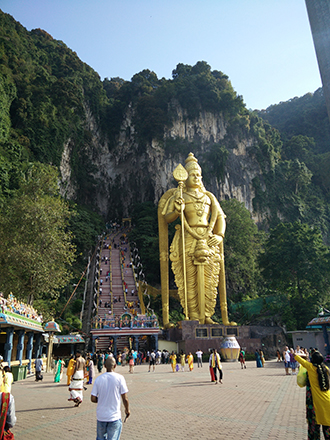 |
Living in multicultural Malaysia gives us a chance to experience magnificent celebrations throughout the year. So when the MCG events team sent out its invitation for the annual excursion to Batu Caves for the Hindu Thaipusam festival, I didn’t hesitate for a moment and signed up immediately.
Even though I grew up in India, the country responsible for the origin of the festival, I had never had the chance to witness the spectacle first hand as the festivities are limited mainly to the Southern Indian state of Tamil Nadu.
Malaysia and Singapore are home to large Tamil communities, and Thaipusam is celebrated on a grand scale in both countries. In Kuala Lumpur, the epicenter of the Thaipusam is a limestone hill in the district of Gombak, located at a distance of 16 km from Kuala Lumpur city. This lofty hill hosts magnificent cave temples and is perhaps the most famous Hindu shrine outside the subcontinent.
The Batu Cave temples are dedicated to Lord Murugan, the Hindu god of war and a towering, gold statue of this son of celestial couple Lord Shiva and his wife Parvati, the goddess of fertility, love and devotion stands sentinel in front of the many steps that lead up to the temples. |
|
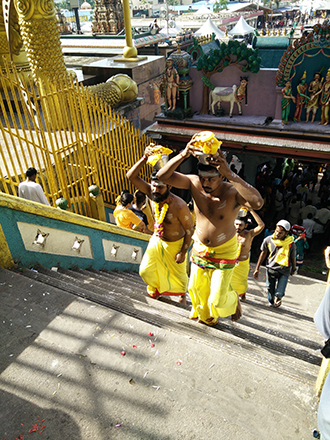 |
On the eve of the Thaipusam festival a century-old silver chariot sets out from the Sri Mahamariamman Temple near the Central Market and traverses 16 km to the Batu Caves. The chariot is symbolic of Lord Murugan coming out to greet his people. Throngs of worshippers usually accompany the chariot and present offerings of milk, fruit and flowers. Many also smash coconuts along the route for this represents the act of banishing ego and pride and submission to the Lord. Our group assembled at the exit of the Batu Caves, KTM commuter station on the designated day of our expedition, which was two days before the main event. Once it was ascertained that we were all there, the immensely knowledgeable, experienced and enthusiastic Cheryl Hoffmann gave us a background of the festival as she explained the various rituals and traditions involved in the celebration of Thaipusam. Cheryl proceeded to lead us through the ornately carved temple gate into the temple grounds, and we joined the throngs of yellow-clad devotees bearing offerings as we began to climb the 272 steps cut into the hill, which lead up to the temples. |
|
 |
Accompanied by the cacophonous sounds of drums, cymbals, and trumpets emitting from the entourages of devotees crying ‘vel’ ‘vel’ we made our way to the summit. The climb didn’t seem that arduous for we had a couple of rest stops en-route while we gingerly dodged the many mischievous macaques, who reside in the cave temples and fearlessly attack climbers as they look to grab any food or beverage.
Several small temples occupy the summit of the hill. The most famous temple is the home of Lord Murugan, and it is here that the devotees terminate their journey and make their offerings.
After observing the rituals and visiting the temple, we made our way down the hill and proceeded to enjoy a delicious banana leaf lunch at Dhivya’s Café located on the temple grounds.
Soon after, our satiated but hot and sweaty bunch boarded the next KTM train back to KL Sentral. |
|
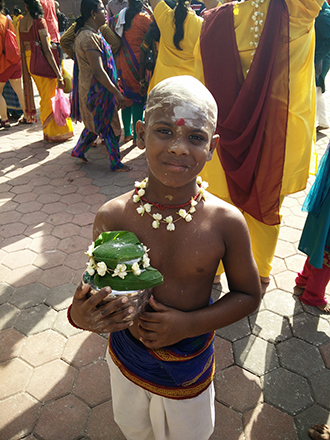 |
When is Thaipusam? The Tamil calendar uses the solar cycle. Accordingly, Thaipusam occurs every year between mid-January and mid-February. This period coincides with the Tamilian solar month, Thai.
Why Thaipusam? Thaipusam is celebrated in honor of Lord Murugan, the granter of wishes. Tamilian immigrants from India first celebrated the festival in Malaysia in 1888.
Why are the temples located at the Batu Caves site? All temples dedicated to Lord Murugan are usually perched atop a hill. This logistic peculiarity has a story behind it.
Traditions and customs associated with Thaipusam Devotees believe they need to do penance before Lord Murugan can grant their wishes. In the days running up to the festival, many devotees fast or follow only a liquid diet. Others adopt a strict vegetarian diet as they practice celibacy and meditate. The penance, which usually extends over forty-eight days, helps devotees banish negative emotions of lust, greed, ego, anger and hate. |
|
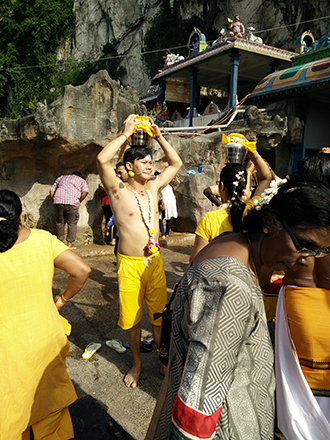 |
The festival continues over three to four days. Before climbing the hill to get to the temple, many devotees get their heads shaved and anointed with ash and turmeric at the makeshift temple kiosks that are erected on the temple grounds and the banks of the nearby Sungei Batu. Female and child devotees typically carry milk pots (paal kadam) on their heads as offerings. Worshippers wear yellow or saffron for Thaipusam as yellow is considered to be sacred to Hindus. Some worshippers go into a trance and pierce parts of their anatomy during their pilgrimage. These piercings help the devotee to be focused on their journey. Piercings made on the tongue and cheeks prevent the worshipper from speaking and getting distracted.
Kavadi Aside from milk pots, many devotees carry elaborate, large and heavy altars on their heads. These altars called Kavadi feature peacock feathers, miniature idols of deities, garlands, lights and more. A noisy group of musicians and supporters accompany the kavadi-bearer, and they play music and chant as they encourage and support him. |
|
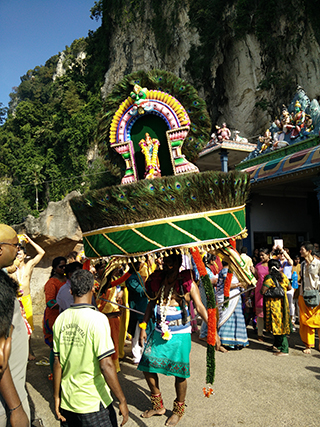 |
Shiva and Parvati’s other offspring Ganesh once cleverly outwitted his brother Murugan to snag a prize offered by his parents. A peeved Murugan then got on his favorite vehicle, the speedy peacock and went and hid in a cave in the hills. He went on to sulk for a while. Ultimately, his mother Parvati had to go and coax him to come out. She also at this time gave him a vel or a spear to vanquish the evil demon Sopardam. All depictions of Lord Murugan show him standing tall with his vel. The altar called kavadi signifies the ‘act of carrying.’ The myth associated with the kavadi is that a holy man Sage Agasthya wanted to move to hills from north India to south India. He entrusted a lad called Idumban with the task. Idumban slung the hills across his shoulders and set off on his journey. He stopped to rest near the town of Palani where Lord Murugan was in exile. Murugan perched on top of one of the hills when Idumban was asleep. When Idumban awoke, he was unable to lift his weighty burden. During the battle that ensued Idumban lost his life but Lord Murugan resurrected him. Idumban went on to become Lord Murugan’s most trusted disciple. Every temple dedicated to Murugan has a shrine dedicated to Idumban as well. |
|
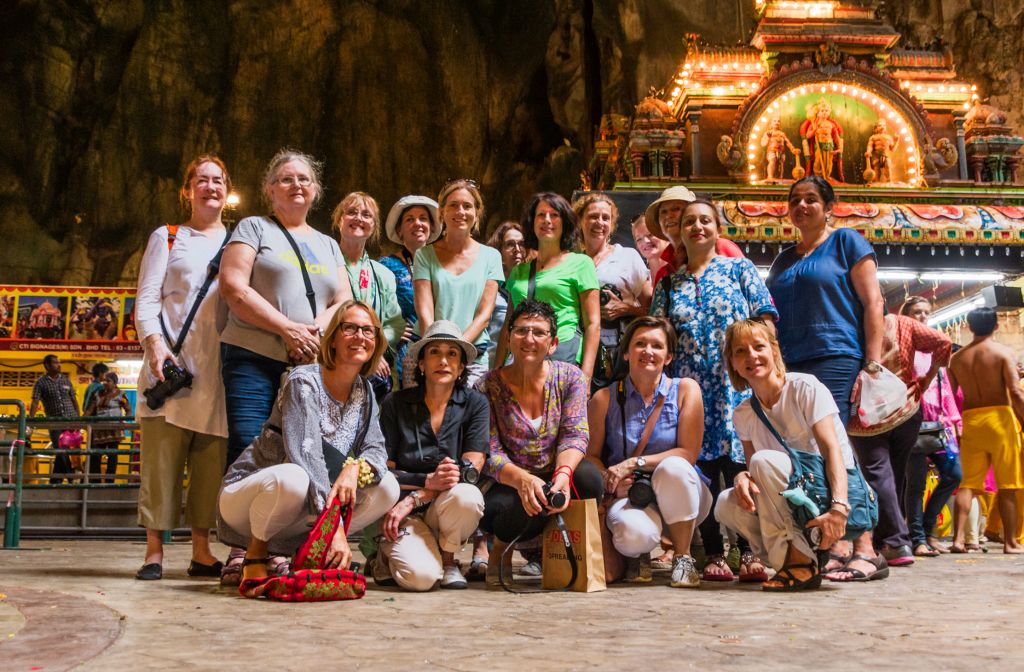 |
||
| Submitted by Anjeeta Nayar | ||




